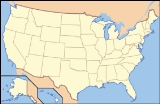
Noatak National Preserve
Encyclopedia
The Noatak National Preserve is an United States
National Preserve
in northwestern Alaska
that was established to protect the Noatak River
Basin. The Noatak River system, located just north of the Arctic Circle
, is thought to be the last remaining complete river system in the United States that has not been altered by human activities.
The Noatak Basin is a transition zone for plants and animals between Arctic and subarctic environments. Wildlife of the Noatak tundra
includes moose
, grizzly bear
s, black bear
s, wolves, arctic fox
es, lemming
s, Dall sheep
, vast herds of Caribou numbering more than 500,000 individuals, and a variety of birds.
The basin was proclaimed a United States National Monument
in 1978 and a National Preserve in 1980 through the passage of the Alaska National Interest Lands Conservation Act
. Noatak National Preserve borders Kobuk Valley National Park
on the south and borders Gates of the Arctic National Park on the east. Unlike the National Parks that it borders, sport hunting is allowed in Noatak National Preserve.
United States
The United States of America is a federal constitutional republic comprising fifty states and a federal district...
National Preserve
National preserve
National Preserve is a designation applied by the United States Congress to protected areas that have characteristics normally associated with U.S. National Parks but where certain activities not allowed in National Parks are permitted. These activities include public hunting, trapping, and oil...
in northwestern Alaska
Alaska
Alaska is the largest state in the United States by area. It is situated in the northwest extremity of the North American continent, with Canada to the east, the Arctic Ocean to the north, and the Pacific Ocean to the west and south, with Russia further west across the Bering Strait...
that was established to protect the Noatak River
Noatak River
The Noatak River is a river in northwestern Alaska. The river's headwaters are on tall Mount Igikpak in the Schwatka Mountains of the Brooks Range in the Gates of the Arctic National Park. The Noatak flows generally westward approximately to the Chukchi Sea at Kotzebue Sound. The river's entire...
Basin. The Noatak River system, located just north of the Arctic Circle
Arctic Circle
The Arctic Circle is one of the five major circles of latitude that mark maps of the Earth. For Epoch 2011, it is the parallel of latitude that runs north of the Equator....
, is thought to be the last remaining complete river system in the United States that has not been altered by human activities.
The Noatak Basin is a transition zone for plants and animals between Arctic and subarctic environments. Wildlife of the Noatak tundra
Tundra
In physical geography, tundra is a biome where the tree growth is hindered by low temperatures and short growing seasons. The term tundra comes through Russian тундра from the Kildin Sami word tūndâr "uplands," "treeless mountain tract." There are three types of tundra: Arctic tundra, alpine...
includes moose
Moose
The moose or Eurasian elk is the largest extant species in the deer family. Moose are distinguished by the palmate antlers of the males; other members of the family have antlers with a dendritic configuration...
, grizzly bear
Grizzly Bear
The grizzly bear , also known as the silvertip bear, the grizzly, or the North American brown bear, is a subspecies of brown bear that generally lives in the uplands of western North America...
s, black bear
American black bear
The American black bear is a medium-sized bear native to North America. It is the continent's smallest and most common bear species. Black bears are omnivores, with their diets varying greatly depending on season and location. They typically live in largely forested areas, but do leave forests in...
s, wolves, arctic fox
Arctic fox
The arctic fox , also known as the white fox, polar fox or snow fox, is a small fox native to Arctic regions of the Northern Hemisphere and is common throughout the Arctic tundra biome. The Greek word alopex, means a fox and Vulpes is the Latin version...
es, lemming
Lemming
Lemmings are small rodents, usually found in or near the Arctic, in tundra biomes. They are subniveal animals, and together with voles and muskrats, they make up the subfamily Arvicolinae , which forms part of the largest mammal radiation by far, the superfamily Muroidea, which also includes rats,...
s, Dall sheep
Dall Sheep
The Dall sheep , Ovis dalli, is a species of sheep native to northwestern North America, ranging from white to slate brown in color and having curved yellowish brown horns...
, vast herds of Caribou numbering more than 500,000 individuals, and a variety of birds.
The basin was proclaimed a United States National Monument
U.S. National Monument
A National Monument in the United States is a protected area that is similar to a National Park except that the President of the United States can quickly declare an area of the United States to be a National Monument without the approval of Congress. National monuments receive less funding and...
in 1978 and a National Preserve in 1980 through the passage of the Alaska National Interest Lands Conservation Act
Alaska National Interest Lands Conservation Act
The Alaska National Interest Lands Conservation Act was a United States federal law passed in 1980 by the U.S. Congress and signed into law by President Jimmy Carter on December 2 of that year....
. Noatak National Preserve borders Kobuk Valley National Park
Kobuk Valley National Park
Kobuk Valley National Park is in northwestern Alaska north of the Arctic Circle. It was designated a United States National Park in 1980 by the Alaska National Interest Lands Conservation Act. It is noted for the Great Kobuk Sand Dunes and caribou migration routes. The park offers backcountry...
on the south and borders Gates of the Arctic National Park on the east. Unlike the National Parks that it borders, sport hunting is allowed in Noatak National Preserve.

